UnderMiner
Silver Member
- Jul 27, 2014
- 3,818
- 9,726
- 🥇 Banner finds
- 2
- Detector(s) used
- Minelab Excalibur II, Ace 250
- Primary Interest:
- All Treasure Hunting
Found some very old silver in the city's trash last night. The four serving spoons and forks on the left have sterling handles and date to the 1930's, the two spoons on the right are solid silver and are from the mid-late 1700's:
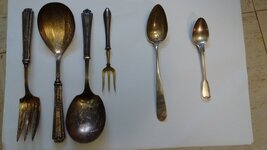
Not sure of the maker but this is a 18th century '13 Loth' silver spoon in the 'Old English' style. It likely originates from Prussia, Austria, or one of the smaller Germanic states of Europe. 13 Loth is an archaic European silver purity mark that officially translates to roughly 81.3% silver. The spoon weighs 26.1 grams. Taking into account the weight and purity it seems likely this spoon was fashioned from a single silver coin, likely the Austrian Maria Theresa silver Thaler which had a very similar purity and weight (purity of 83.3% and weighed 26.3 grams).
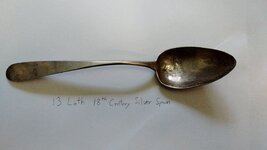
Here we can see the purity stamp '13' and next to it is likely either the maker's mark or assayer stamp:
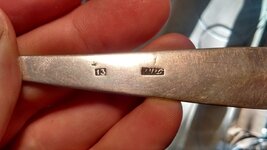
Possibly the maker or assay stamp:
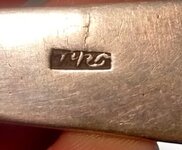
Initials of original owner:
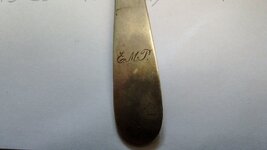
This is an 18th century 'Fiddle Thread' spoon. As of yet I haven't figure out any of the markings, although the '12' may be a '12 Loth' silver purity stamp. This type of spoon enjoyed the most popularity from the mid-late 1700's and was a particular favorite of King Louise XVI and well-to-do French aristocrats before the French Revolution.
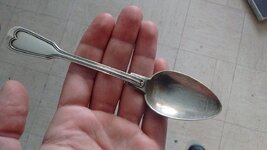
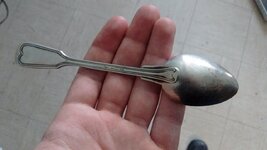
Assayer/purity stamps partially rubbed away:
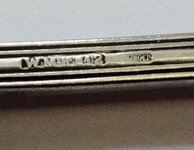
Finally, this is the silver stamp on the unusual 1930's silver-handled olive fork. The 'crown and crescent' mark stand for Germany and the '800' is a purity mark for '80% silver':
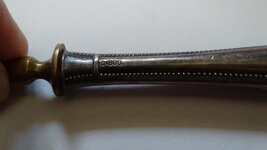

Not sure of the maker but this is a 18th century '13 Loth' silver spoon in the 'Old English' style. It likely originates from Prussia, Austria, or one of the smaller Germanic states of Europe. 13 Loth is an archaic European silver purity mark that officially translates to roughly 81.3% silver. The spoon weighs 26.1 grams. Taking into account the weight and purity it seems likely this spoon was fashioned from a single silver coin, likely the Austrian Maria Theresa silver Thaler which had a very similar purity and weight (purity of 83.3% and weighed 26.3 grams).

Here we can see the purity stamp '13' and next to it is likely either the maker's mark or assayer stamp:

Possibly the maker or assay stamp:

Initials of original owner:

This is an 18th century 'Fiddle Thread' spoon. As of yet I haven't figure out any of the markings, although the '12' may be a '12 Loth' silver purity stamp. This type of spoon enjoyed the most popularity from the mid-late 1700's and was a particular favorite of King Louise XVI and well-to-do French aristocrats before the French Revolution.


Assayer/purity stamps partially rubbed away:

Finally, this is the silver stamp on the unusual 1930's silver-handled olive fork. The 'crown and crescent' mark stand for Germany and the '800' is a purity mark for '80% silver':

Upvote
17


 Cool finds!!!
Cool finds!!!
